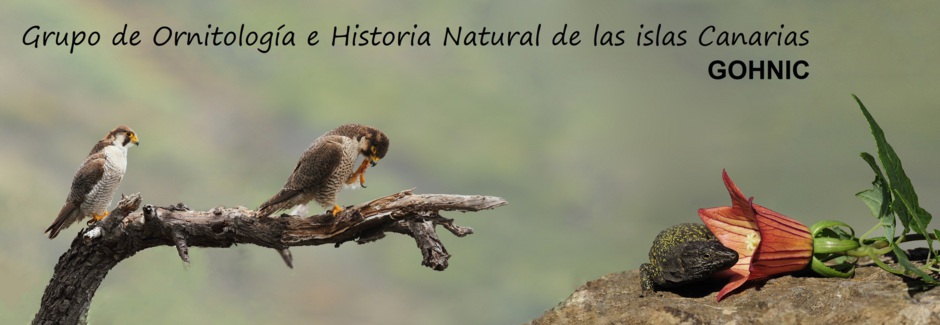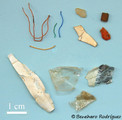
Under construction
Insular biodiversity news
Like in many other regions, the production of scientific works related to insular Macaronesian biodiversity has increased considerably during recent years. Long after those first and scarce publications at the end of the 19th century, always in the hands of visiting naturalists, today it has change to the constant local and foreign contributions in journals of different “ranking”.
This section briefly reviews part of the information which currently exists in notes and articles on the Macaronesian islands over a long period of time. Each review contains a brief headline which shows a) the corresponding field with its numerical reference (this will identify supplementary graphic material if it’s illustrated), and b) the island(s), its corresponding archipelago and, in brackets, when the field work was carried out. The review itself consist of a short title (in bolt), a description comprising of a few lines, and the related bibliographic reference.
We would like to thanks all those (photographers and/or authors) who kindly provided us with photographs, suggested captions or sent PDF to complement the reviews of this section.
Conser 1. Santa Luzia, Cape Verde Islands (2010)
Diet of feral cats in the island of Santa Luzia, Cape Verde. The house mouse (Mus musculus) was the feral cats’ (Felis catus) main prey in Santa Luzia, an island which is now uninhabited, barely 35 km² and situated in the Barlavento sector of Cape Verde. The reptiles represented by a scincid lizard (Chioninia stangeri) and an unidentified gecko were the second most preyed on animals. Although it will be necessary to carry out further studies in the future, in the 26 groups of cat excrements analysed none of the prey-species were endanger. Medina y col., 2012 (Zoologia Caboverdiana 3: 67-73)
Ecol 4. Tenerife, Canary Islands (2005-09)
Nectarivory: legitimate visits of the Canary Lizard to flowers of Canarian plants.This note describes the first observations of the Canary Lizard (Gallotia galloti) feeding on nectar of bicácaro (Canarina canariensis, family Campanulaceae)) and pico de El Sauzal (Lotus maculatus, Rhyncholotus group, family Fabaceae). Referring to the last species, endemic to Tenerife and critically endangered, such interactions could represent the only form of pollination, at least in its natural and very scarce population. Siverio y Rodríguez-Rodríguez, 2013 (Herpetological Review 43: 333-334)
Bot 1. Porto Santo, Madeira archipelago (2005-09)
A new species of “taginaste” from the island of Porto Santo. The separation of Echium portosanctensis (family Boraginaceae) from other similar species is based on morphological studies, especially in vegetative and reproductive traits. It is a plant with a very reduced population size and restricted to two sites in Porto Santo (200-450 m a.s.l.), somewhat influenced by the sea winds and with a well-developed rupicolous vegetation. Carvalho y col., 2010 (Anales del Jardín Botánico de Madrid 67: 87-96)
Ornithol 3. Tenerife, Canary Islands (2009-11)
Adults Corys’ Shearwaters bring junk food to their nestlings. Every year, thousands of Corys’ Shearwater fledglings (Calonectris diomedea) are attracted by the artificial lights when they make the first flights from the nests to the sea. Taking advance of the unfortunate death of some fledglings affected by this phenomenon, 85 individuals were dissected in search of plastic particles in its stomach content (see video). At least 83.5% contained plastic pieces measuring an average of 8.7 mm. Rodríguez y col., 2012 (Marine Pollution Bulletin 64: 2219-2223)
Mastozool 1. Tenerife and La Gomera, Canary Islands (1987-?)
New subspecies of Western Barbastelle from the Canary Islands. Barbastella barbastellus guanchae described from the Canary Islands, a subspecies of Western Barbastelle whose morphological differences are its dark brown dorsal coat and a pale band in the form of a U on the lower edge of its under parts. This new taxon, only detected in Tenerife and La Gomera until now, shows a certain preference for forestal environments and it is the rarest bat among all those in the Canarian Archipelago. Trujillo y col., 2002 (Revue suisse de Zoologie 109: 543-550)
Ornithol 2. Boavista, Cape Verde Islands (2008-12)
Has the end finally arrived for the Magnificent Frigatebird in the Cape Verde Islands? The scarce sightings of the Magnificent Frigatebird (Fregata magnificens) during recent years and the discovery, in September 2012, of a female carcass on the southeast coast of Boavista could be the prelude of its imminent extinction in Cape Verde. López Suárez y col., 2012 (Zoologia Caboverdiana 3: 82-86)
Ecol 3. Madeira, Madeiran archipelago (2001)
Bird pollination in Madeira. Observations on the Blackap (Sylvia atricapilla) visiting the flowers of two different plant species endemic to the island of Madeira, Isoplexis sceptrum and Musschia wollastonii, represent the first data on nectarivory and putative pollination by birds in this archipelago. Olesen y Valido, 2003 (Ardeola 50: 67-69)
Ecol 2. Selvagem Grande, Savage Islands (2006-07)
Madeiran Wall Lizards preying upon Cory’s Shearwater hatchlings. The natural distribution of the Madeiran Wall Lizards (Teira dugesii) comprises of several islands in the North-eastern Atlantic (Madeira and Savage archipelagos). In Selvagem Grande, the largest of the Savage Islands, there were at least 40 cases confirmed in which these reptiles were preying on Cory’s Shearwater hatchlings (Calonectris diomedea). Predation, carried out by lizards of all ages, occurred during or immediately after hatching, and in general inside the nest cavities. Out of 63 unsuccessful shearwater nests recorded throughout the entire study period, 19% were a result of the lizards' activities. Matias y col., 2009 (Waterbirds 34: 600-603)
Ornithol 1. Fuerteventura, Canary Islands (2000-03)
Divorce in the Canary Islands Stonechat.The Canary Islands Stonechat (Saxicola dacotiae) is a small passerine bird endemic to the island of Fuerteventura. A female, belonging to one of the 72 pairs studied, divorced after her first successful breeding (together with the male, she reared three chicks) and settled down in a nearby territory occupied by an unpaired male. Here she built a new nest and laid four eggs. Illera, 2005 (Wilson Bulletin 117: 317-319)
Malacol 1. La Gomera, Canary Islands (2006-07)
Active camouflage of Canarian land snails. The main habitat of Napaeus barquini (family Enidae), a terrestrial snail exclusive to La Gomera and described in 2006, consists of rocky walls covered with crustacean lichens. Probably with the intention of going unnoticed, this species, following a standard procedure, grazes lichens and dispenses them all over its shell forming small protuberances (see video), which become stickier the drier they get. Allgaier, 2007 (Zoological Science 24: 869-876)
Ecol 1. El Hierro, Canary Islands (2007)
Nectarivory in the Caesar´s Lizard. Despite the high number of observations on nectar feeding by Canarian lizards (Gallotia spp.), in most cases the role they play in pollination still needs to be clarified. To this growing list of nectarivory sightings, in which the Canary Lizard (G. galloti) is the primary species, new data concerning the Caesar´s Lizard (G. caesaris) from the island of El Hierro has now been added: at least two individuals visit the flowers of several inflorescences belonging to the same plant of ajinajo manso (Echium hierrense, family Boraginaceae). All visits seemed to be legitimate, that´s to say, the reptile´s snout came in contact with the anthers and stigmas when licking the nectar from the floral receptacles. Siverio y Rodríguez-Rodríguez, 2011 (Herpetological Review 42: 602-603)
















